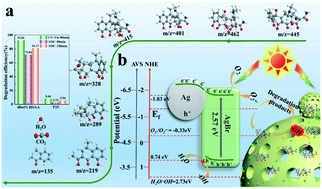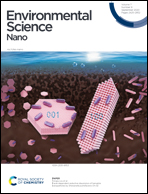A gourd-like hollow mesoporous silica particle-supported Ag/AgBr Schottky junction for highly efficient mineralization of tetracycline hydrochloride†
Abstract
Tetracycline hydrochloride (TTC), a typical antibiotic with biological toxicity, is very harmful to the ecosystem. Photocatalysis is considered an effective method for solving this problem. However, traditional photocatalysts have limited light response, poor charge transport, and low adsorption ability, which substantially limit their application. Herein, gourd-like hollow mesoporous silica (HS) particles with considerable BET surface area (1181.57 m2 g−1) and enhanced light absorption were constructed to support the Ag/AgBr Schottky junction. Photoelectrochemical characterizations confirmed that the optical response and charge transfer of the fabricated photocatalysts were significantly elevated because the synergistic effect of the Ag/AgBr Schottky junction and amino-modified gourd-like HS particles facilitated the effective generation of ˙OH radicals. The optimal HS-Ag/AgBr (40 wt% HSAA) exhibited highest TTC degradation activity (3.79 × 10−2 min−1) owing to a redox reaction with O2˙−/˙OH radicals, which was about 28.3-fold greater than the commercial P25 (1.34 × 10−3 min−1) and 12.8-fold greater than the AgBr (2.96 × 10−3 min−1). Most importantly, about 72.04%/81.17% of TTC was mineralized by optimal 40 wt% HSAA after 90 min/150 min of illumination, which was higher than those with P25 and other Ag/AgBr-based photocatalysts reported in the literature. Therefore, TTC and its by-products could be completely decomposed by this novel structure, and this study provides a prospective approach for the effective handling of antibiotic pollution in the ecosystem.



 Please wait while we load your content...
Please wait while we load your content...